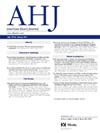心室-动脉耦合与系统性右心室患者的临床结果相关。
IF 3.7
2区 医学
Q1 CARDIAC & CARDIOVASCULAR SYSTEMS
引用次数: 0
摘要
背景:成人大动脉转位(TGA)和系统性右心室(SRV)有心力衰竭(HF)和生存率降低的风险。心室-动脉耦合(VAC)量化心肌收缩功能与动脉循环负荷之间的相互作用,可能对识别亚临床SRV功能障碍有价值。我们研究的目的是确定VAC与TGA和SRV成人不良临床结果的关系。方法:采用单中心、回顾性队列研究,对年龄≥16岁的TGA和SRV患者进行心脏磁共振(CMR)检查。VAC计算为cmr衍生的SRV收缩期末容积与卒中容积之比。采用Cox比例风险回归分析来评估VAC与临床结果的关系。结果:共纳入167例受试者,平均年龄32±10岁,男性59%。VAC预测死亡、心脏骤停和心力衰竭住院的综合结局(风险比2.09;95% CI: 1.12-3.92, p = 0.02),以及其他心血管住院治疗,包括器械植入和经皮或手术结构干预(HR 1.65, 95% CI: 1.09-2.49, p = 0.02),在调整了年龄、性别和明显三尖瓣反流的存在后。结论:VAC与TGA和SRV患者的主要临床不良结局相关,并可能改善这一复杂人群的风险分层。本文章由计算机程序翻译,如有差异,请以英文原文为准。

Ventricular-arterial coupling is associated with clinical outcomes in patients with systemic right ventricle
Background
Adults with transposition of the great arteries (TGA) and systemic right ventricle (SRV) are at risk for heart failure (HF) and decreased survival. Ventricular-arterial coupling (VAC) quantifies the interaction between myocardial contractile function and the load imposed by the arterial circulation and may be valuable in identifying subclinical SRV dysfunction. The purpose of our study is to determine the association of VAC with adverse clinical outcomes in adults with TGA and SRV.
Methods
A single center, retrospective cohort study of subjects ≥16 years of age with TGA and SRV who underwent a cardiac magnetic resonance (CMR) examination. VAC was calculated as the ratio between CMR-derived SRV end-systolic volume and stroke volume. Cox proportional hazards regression analysis was performed to assess the association of VAC with clinical outcomes.
Results
One hundred sixty-seven subjects (mean age 32 ± 10 years, 59% males) were evaluated. VAC predicted the composite outcome of death, cardiac arrest and HF hospitalizations (hazard ratio (HR) 2.09; 95% CI, 1.12-3.92, P = .02), as well as other cardiovascular hospitalizations including device implantation and percutaneous or surgical structural intervention (HR 1.65, 95% CI, 1.09-2.49, P = .02) after adjustment for age, sex, and the presence of significant tricuspid regurgitation.
Conclusions
VAC is associated with major clinical adverse outcomes in patients with TGA and SRV, and may improve risk stratification of this complex population.
求助全文
通过发布文献求助,成功后即可免费获取论文全文。
去求助
来源期刊

American heart journal
医学-心血管系统
CiteScore
8.20
自引率
2.10%
发文量
214
审稿时长
38 days
期刊介绍:
The American Heart Journal will consider for publication suitable articles on topics pertaining to the broad discipline of cardiovascular disease. Our goal is to provide the reader primary investigation, scholarly review, and opinion concerning the practice of cardiovascular medicine. We especially encourage submission of 3 types of reports that are not frequently seen in cardiovascular journals: negative clinical studies, reports on study designs, and studies involving the organization of medical care. The Journal does not accept individual case reports or original articles involving bench laboratory or animal research.
 求助内容:
求助内容: 应助结果提醒方式:
应助结果提醒方式:


